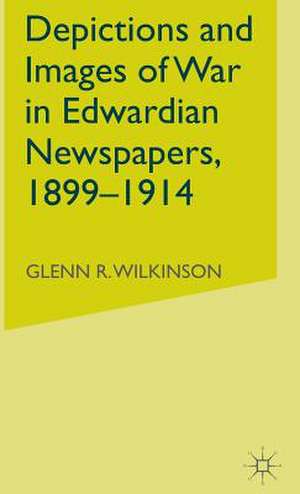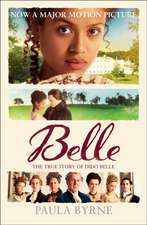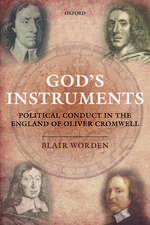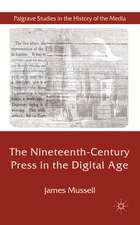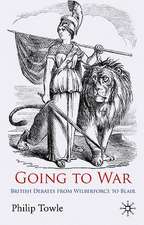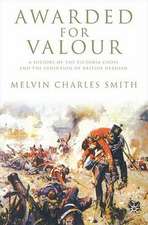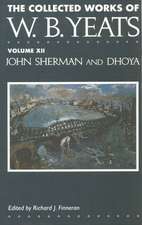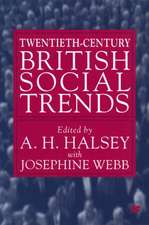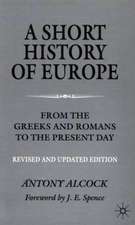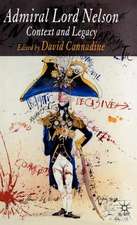Depictions and Images of War in Edwardian Newspapers, 1899-1914
Autor G. Wilkinsonen Limba Engleză Hardback – 13 dec 2002
Preț: 639.08 lei
Preț vechi: 751.86 lei
-15% Nou
Puncte Express: 959
Preț estimativ în valută:
122.29€ • 128.00$ • 101.78£
122.29€ • 128.00$ • 101.78£
Carte tipărită la comandă
Livrare economică 31 martie-14 aprilie
Preluare comenzi: 021 569.72.76
Specificații
ISBN-13: 9780333717431
ISBN-10: 0333717430
Pagini: 200
Ilustrații: XIV, 185 p.
Dimensiuni: 140 x 216 x 15 mm
Greutate: 0.38 kg
Ediția:2003
Editura: Palgrave Macmillan UK
Colecția Palgrave Macmillan
Locul publicării:London, United Kingdom
ISBN-10: 0333717430
Pagini: 200
Ilustrații: XIV, 185 p.
Dimensiuni: 140 x 216 x 15 mm
Greutate: 0.38 kg
Ediția:2003
Editura: Palgrave Macmillan UK
Colecția Palgrave Macmillan
Locul publicării:London, United Kingdom
Cuprins
List of Figures Preface Acknowledgements They Were Taught To Howl: Introduction Uncouth, Unkempt Barbarians: The Depiction of Belligerents The Woof and Warp of the Web of Life: The Depiction of the Use of Force The Great Game of War: The Image of War as Sport and Hunting This Wonderfully Lovely Theatre of War: The Imagery of Stage and Spectacle A Withering Fire that Mowed Them Down in Heaps: Images of Death and Wounding Conclusion: The Blessings of War Index
Recenzii
'[It] explores the images of soldiers and of warfare prevalent in British newspapers before the First World War. It is a sobering account of a society blind to the chaotic waste and suffering of military conflict, which is rendered more poignant by current events, and by Glenn R. Wilkinson's observation that today we too possess a woefully unrealistic image of warfare...How did this blindness come about? Wilkinson is too sophisticated to regard it as forced upon Edwardian society, rejecting notions of propaganda, and observing that commercial mass-circulation newspapers cannot achieve such results without the willing consent of readers...This monograph - conceived in the aftermath of the Gulf War, and completed in the shadow of the September 11 attacks - suggests instead that the Edwardians gazed too long at war and considered it too little. They watched the images of war brought to them by the media, but did little to prevent its advance, until it was so deeply ingrained in their culture that it could no longer be either questioned or challenged. In this way, Wilkinson concludes bleakly, we are no different from our Edwardian ancestors.' - Nicholas Hiley, Times Literary Supplement
'Wilkinson is able to shed considerable light on how the British viewed war during the generation before they were required to support and make sense of the Great War...Wilkinson's nuanced descriptions of numerous papers deserve high praise, as does his labour-intensive methodology andengaging style. His arguments, moreover, add a valuable window into Edwardian cultural history...this is a significant work of cultural history that does much to explain the disillusionment of those soldiers who found the reality of the Great War very different from the images on which they had been raised.' - Mark Hampton, Wesleyan College, Twentieth Century British History
'Wilkinson is able to shed considerable light on how the British viewed war during the generation before they were required to support and make sense of the Great War...Wilkinson's nuanced descriptions of numerous papers deserve high praise, as does his labour-intensive methodology andengaging style. His arguments, moreover, add a valuable window into Edwardian cultural history...this is a significant work of cultural history that does much to explain the disillusionment of those soldiers who found the reality of the Great War very different from the images on which they had been raised.' - Mark Hampton, Wesleyan College, Twentieth Century British History
Notă biografică
GLENN R. WILKINSON is an instructor in the Humanities Department of Mount Royal College in Calgary, Alberta, Canada where he teaches European and Intellectual History. He has written several articles on images of war in newspapers.
